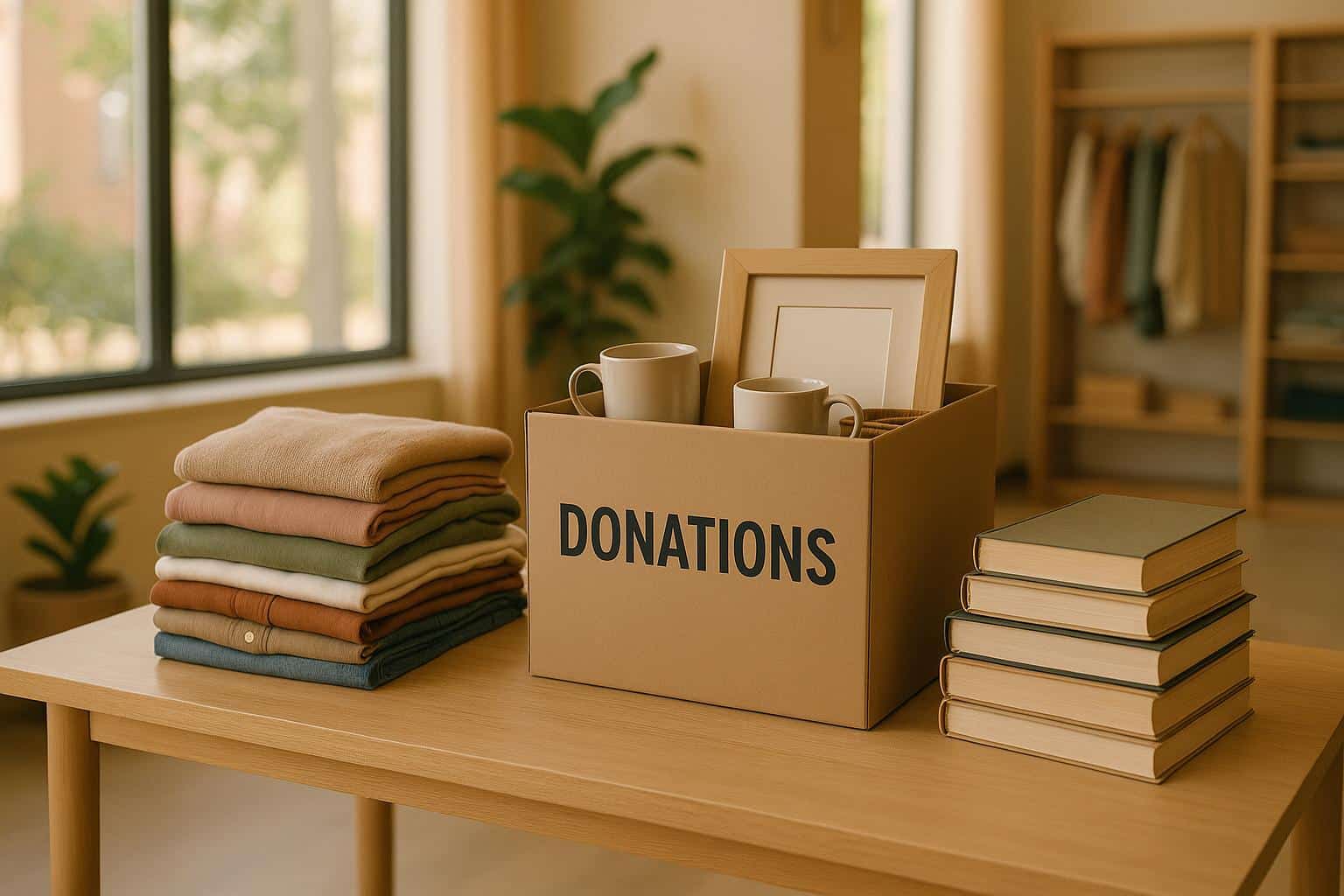
Thrift shopping is a simple way to save money, reduce waste, and support local communities.
By choosing secondhand items, you help reduce the 11 million tons of textile waste produced annually in the U.S. and lower the demand for resource-heavy production, like the 1,800 gallons of water it takes to make one pair of jeans. Plus, stores like Red Racks Thrift Stores use proceeds to fund services for veterans, including medical care, job training, and housing assistance.
Key Takeaways:
- Environmental Benefits: Reduce waste, conserve resources, and lower pollution by buying pre-owned items.
- Community Impact: Support local programs, create jobs, and fund veteran services.
- Shopping Tips: Inspect items for quality, visit stores often, and plan your purchases to avoid overbuying.
- Donation Tips: Donate clean, gently used items to extend their life and help others.
By shopping or donating at thrift stores, you make a positive impact on the planet and your community.
How Thrift Shopping Helps
Thrift shopping offers a dual benefit: it helps the planet and supports local communities by conserving resources and funding critical services.
Reducing Waste and Saving Resources
Every thrift store purchase makes a difference. Buying pre-owned items reduces the demand for new production, saving resources and cutting down on pollution. It also keeps items out of landfills and decreases the need for raw material extraction.
Here’s how it helps cut down environmental harm:
- Uses less water during manufacturing
- Lowers chemical pollution from production processes
- Reduces carbon emissions linked to making new items
- Decreases dependence on synthetic fibers
These benefits ripple into communities, as seen in Red Racks‘ efforts to support local initiatives.
Supporting Local Communities
Thrift shopping doesn’t just help the environment – it also strengthens local communities. For example, Red Racks Thrift Stores work with Disabled American Veterans (DAV) to fund services like:
- Access to medical care
- Job training opportunities
- Housing assistance
- Support for transitioning to civilian life
Thrift stores also create jobs and provide affordable shopping options. Many locations go further by offering job training and employment placement programs, helping individuals build lasting careers.
Comparing New and Used Items
| Impact Area | New Items | Pre-Owned Items |
|---|---|---|
| Environmental | Requires raw materials and energy-intensive production | Extends product life and reduces waste |
| Resource Use | High water and energy consumption | Minimal additional resources needed |
| Community | Limited local economic impact | Supports local programs and veteran services |
| Cost | Full retail pricing | Budget-friendly options |
| Sustainability | Adds to manufacturing pollution | Reduces demand for new production |
Choosing secondhand reflects a growing awareness of personal responsibility. 69% of people worldwide believe that sustainability starts with individual actions. Through Red Racks Thrift Stores, these personal choices lead to a larger collective impact, benefiting both the environment and critical veteran services.
Getting Started at Thrift Stores
Ready to dive into thrift shopping? Here’s how to make the most of your experience and score great finds.
Before You Shop
Start by planning. Look up thrift store locations in your area and check when they restock. Visiting early on restock days can give you a better chance of finding standout pieces.
How to Check Item Quality
When shopping, take the time to carefully inspect items. The process will vary depending on what you’re looking for.
Clothing Tips:
- Look at seams and stitching to spot loose threads or weak construction.
- Examine the fabric for stains, tears, or heavy wear.
- Test zippers, buttons, and clasps to ensure they work.
- Check labels for material details and care instructions.
Furniture and Home Goods Tips:
- Inspect joints and connections to ensure they’re sturdy.
- Check for stability and structural soundness.
- Look for manufacturer marks or labels that might indicate quality.
- Test moving parts like drawers and hinges to see if they function smoothly.
Take Your Time
Thrift shopping rewards patience, so don’t rush. Here are a few strategies to make your trips more productive:
| Strategy | Why It Helps | What You Gain |
|---|---|---|
| Visit often | Stores update their inventory frequently | More chances to find great items |
| Shop during quiet hours | Less crowded aisles | Easier browsing and less competition |
| Explore every section | Hidden treasures can be anywhere | You might find unexpected gems |
| Learn about brands | Recognize high-quality items | Smarter buying decisions |
Taking the time to research brands and verify authenticity can also help you spot quality pieces worth bringing home.
Smart Shopping Methods
Buy What You Need
Start with a plan. Make a list of the essentials before heading out to shop. This helps you avoid unnecessary purchases.
When you do shop, prioritize quality over quantity. Choose brands known for their durability and reliability, such as:
- Clothing: Levi’s, Patagonia
- Footwear: Merrell, Timberland
- Outdoor gear: Columbia
Quick tip: Check the condition of items carefully. Focus on durability and functionality rather than surface appearance.
Once you’ve got your essentials, think about how you might give items a second life through creative reuse.
Ways to Reuse Items
Breathe new life into thrifted finds by turning them into something useful or stylish. Here are some ideas for upcycling:
| Item Type | Upcycling Ideas | Why It Works |
|---|---|---|
| Glass containers | Paint, frost, or decoupage | Adds storage and style |
| Wooden furniture | Sand, paint, or reupholster | Refreshes your home decor |
| Baskets | Line with fabric or add paint | Keeps spaces organized |
| Side tables | Refinish and upgrade | Brings a fresh, stylish touch |
Cost and Resource Savings
Thrifting isn’t just about saving money – it’s also about reducing waste. By buying secondhand, you cut down on landfill contributions and conserve resources. Plus, you can get high-quality items for much less than their original price. It’s a win for your wallet and the planet.
Join Red Racks
How to Donate Items
Give your gently used items a new purpose by donating to Red Racks. Your donations help Disabled American Veterans (DAV) while reducing waste.
Here’s a quick overview of what you can donate:
| Category | Accepted Items | Condition Requirements |
|---|---|---|
| Clothing & Accessories | Clothing, shoes, bags | Clean; minor repairs are fine |
| Home Goods | Small appliances, decor, and tools | Must be in working condition |
| Electronics | Flatscreen TVs (≤2 years old) | Fully functional |
| Fitness Equipment | Treadmills, exercise bikes (≤10 years old) | Good working order |
| Furniture | Tables, chairs, shelving | Free of stains or damage |
Tip: Wash clothes before donating and save your donation receipt for tax deductions.
Your donations do more than declutter – they create opportunities to support veterans and contribute to the community.
Work and Volunteer Options
Looking for meaningful work or volunteer opportunities in Missouri? Red Racks offers roles that make a difference. Their team focuses on creating positive change while supporting veterans through their retail efforts.
Be part of the team if you’re passionate about:
- Giving back to the community
- Supporting veterans
- Providing great customer service
- Reducing waste through reuse
Help Veterans
When you donate or shop at Red Racks, you’re directly contributing to programs that assist veterans. These include:
- Access to medical care
- Job training and employment programs
- Housing support services
- Help with transitioning to civilian life
Shopping or donating at Red Racks helps provide jobs, affordable clothing, and essential resources to communities in need. Consider organizing a neighborhood donation drive to expand support for veterans and reduce waste at the same time. Every small effort adds up!
Next Steps
Start making thoughtful shopping choices with these simple steps:
Plan Your Visit
Prepare ahead by listing the items you need and scheduling regular trips to Red Racks. Don’t forget to bring a reusable bag to cut down on waste. Before buying anything new, check for secondhand options. This not only reduces demand for new production but also supports services for veterans.
Maximize Your Impact
Your choices can have a meaningful effect on both the environment and your community:
| Action | Environmental Benefit | Community Contribution |
|---|---|---|
| Buy Secondhand | Cuts down on textile waste | Helps fund veteran programs |
| Donate Clean Items | Extends product lifespan | Offers affordable options |
| Repair & Repurpose | Reduces landfill waste | Creates one-of-a-kind pieces |
Every small action adds up, creating a ripple effect of positive change.
Check for Quality
When shopping or preparing donations, keep these tips in mind:
- Would you buy this item brand new?
- Do you already own items that complement it?
- Can small flaws or damage be easily fixed?
These questions will help you make better decisions as you shop or declutter.
Take Action Today
Start by gathering items you no longer use. Clean them thoroughly, sort them into categories, and drop them off at your nearest Red Racks location. By choosing to shop and donate responsibly, you’re not just helping the planet – you’re also supporting essential services for disabled veterans.
Every purchase and donation at Red Racks makes a difference for the environment and your community.
FAQs
How can I check the quality of items when shopping at thrift stores?
To ensure you’re getting high-quality finds at thrift stores, take a moment to thoroughly inspect each item before purchasing. Check clothing for stains, tears, missing buttons, or broken zippers that might be difficult or costly to fix. For household goods, confirm that items like electronics or kitchenware are in working order and free of significant damage.
When shopping, prioritize materials known for durability, such as cotton, wool, or leather for clothing and stainless steel or wood for home goods. Small imperfections can often be repaired or repurposed, but avoid items with major flaws that don’t align with your needs or sustainability goals. Taking an extra minute to assess quality ensures your thrifted treasures will last and serve you well.
What are some fun and creative ways to upcycle thrift store finds for my home?
Upcycling thrift store finds is a great way to personalize your home while being eco-friendly. You can repurpose old furniture into unique pieces, like turning a vintage dresser into a chic TV stand or a functional storage bench. Small items like picture frames can be transformed into decorative trays or message boards with a little paint and creativity.
For a quick project, try using mason jars or glassware as candle holders, planters, or even stylish storage containers for your kitchen or bathroom. If you’re into DIY, consider reimagining fabric from thrifted curtains or tablecloths to create throw pillows or reusable tote bags. The possibilities are endless – just let your imagination guide you!
How does donating to Red Racks Thrift Stores support veterans and the local community?
When you donate to Red Racks Thrift Stores, you’re making a meaningful impact on both veterans and the community. Operated by Disabled American Veterans (DAV), these stores use the proceeds from your donations to fund vital programs that assist veterans and their families.
In addition to supporting veterans, your donations help reduce waste by giving items a second life, which benefits the environment. It’s a simple way to declutter your home while contributing to a good cause and fostering a more sustainable, community-focused lifestyle.





